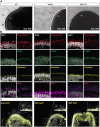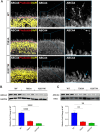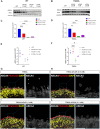Investigation of ABCA4 Missense Variants and Potential Small Molecule Rescue in Retinal Organoids
- PMID: 40693713
- PMCID: PMC12302050
- DOI: 10.1167/iovs.66.9.58
Investigation of ABCA4 Missense Variants and Potential Small Molecule Rescue in Retinal Organoids
Abstract
Purpose: ABCA4-related retinopathy is the most common monogenic eye disorder in the world and is currently untreatable. Missense variants in ABCA4 constitute ∼60% of causal ABCA4-related retinopathy variants, often resulting in misfolded or dysfunctional protein products. Despite their prevalence, the molecular mechanisms by which these missense mutations impair ABCA4 function are not fully understood, primarily due to limitations in suitable cellular models. In this study, we investigated the cellular and molecular consequences of ABCA4 missense variants using a human photoreceptor-like model system.
Methods: We used CRISPR/Cas9 technology to introduce two ABCA4 missense misfolding variants, T983A and R2077W, which are associated with ABCA4-associated retinopathy, into control induced pluripotent stem cells (iPSCs). The iPSCs were differentiated into retinal organoids, characterized and treated with small molecules.
Results: The expression level of ABCA4 missense proteins was reduced compared to WT ABCA4 suggesting the variants were degraded in a photoreceptor-like environment. The localization of the missense variants was also altered with negligible ABCA4 detectable in the retinal organoid outer segments compared to the isogenic control. Two small molecule compounds, AICAR and 4-PBA, previously identified as potential ABCA4 folding correctors in vitro, were tested for their ability to enhance ABCA4 traffic to the outer segment. The compounds did not appear to promote ABCA4 folding and traffic in photoreceptors and instead led to a decrease in ABCA4 transcript levels and protein.
Conclusions: These data highlight that retinal organoids are an exquisite model to investigate pathogenic variants in ABCA4 and test small compounds for translation to the human retina.
Conflict of interest statement
Disclosure:
Figures




Similar articles
-
Small molecule treatment alleviates photoreceptor cilia defects in LCA5-deficient human retinal organoids.Acta Neuropathol Commun. 2025 Feb 11;13(1):26. doi: 10.1186/s40478-025-01943-y. Acta Neuropathol Commun. 2025. PMID: 39934925 Free PMC article.
-
Virus-like particles as robust tools for functional assessment: Deciphering the pathogenicity of ABCA4 genetic variants of uncertain significance.J Biol Chem. 2024 Oct;300(10):107739. doi: 10.1016/j.jbc.2024.107739. Epub 2024 Aug 31. J Biol Chem. 2024. PMID: 39222682 Free PMC article.
-
[Clinical manifestations and genetic variation analysis in six Chinese pedigrees affected with Stargardt disease].Zhonghua Yi Xue Yi Chuan Xue Za Zhi. 2025 May 10;42(5):547-555. doi: 10.3760/cma.j.cn511374-20241220-00669. Zhonghua Yi Xue Yi Chuan Xue Za Zhi. 2025. PMID: 40623925 Chinese.
-
Retinal Organoids from Induced Pluripotent Stem Cells of Patients with Inherited Retinal Diseases: A Systematic Review.Stem Cell Rev Rep. 2025 Jan;21(1):167-197. doi: 10.1007/s12015-024-10802-7. Epub 2024 Oct 18. Stem Cell Rev Rep. 2025. PMID: 39422807 Free PMC article.
-
Systemic treatments for metastatic cutaneous melanoma.Cochrane Database Syst Rev. 2018 Feb 6;2(2):CD011123. doi: 10.1002/14651858.CD011123.pub2. Cochrane Database Syst Rev. 2018. PMID: 29405038 Free PMC article.
References
-
- Illing M, Molday LL, Molday RS. The 220-kDa rim protein of retinal rod outer segments is a member of the ABC transporter superfamily. J Biol Chem. 1997; 272(15): 10303–10310. - PubMed
-
- Weng J, Mata NL, Azarian SM, Tzekov RT, Birch DG, Travis GH. Insights into the function of Rim protein in photoreceptors and etiology of Stargardt's disease from the phenotype in ABCR knockout mice. Cell. 1999; 98(1): 13–23. - PubMed
-
- Lois N, Holder GE, Bunce C, Fitzke FW, Bird AC. Phenotypic subtypes of Stargardt macular dystrophy–fundus flavimaculatus. Arch Ophthalmol. 2001; 119(3): 359–369. - PubMed
MeSH terms
Substances
Grants and funding
LinkOut - more resources
Full Text Sources
Medical

